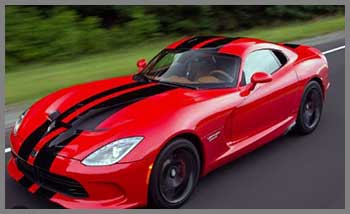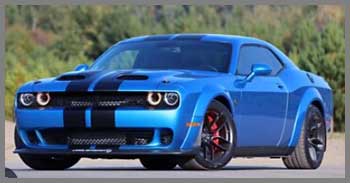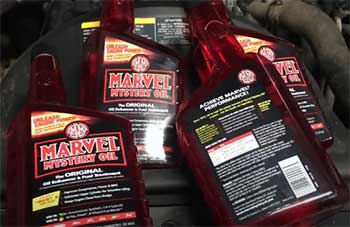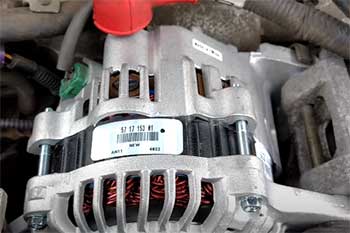
As a lifelong car enthusiast, I’ve always been drawn to the raw power and bold designs of Dodge’s performance vehicles.
The Dodge Viper and Dodge Challenger SRT Hellcat are two iconic machines that embody American muscle, each with its own unique flair and purpose.
This article compares the Dodge Viper, a track-focused supercar, and the Dodge Challenger SRT Hellcat, a supercharged muscle car, to help you decide which is the right fit for your driving passion.
From performance metrics to real-world experiences, I’ll share insights to guide you toward the car that best suits your needs.
Comparison Table: Dodge Viper Vs. Dodge Challenger SRT Hellcat
| Feature | Dodge Viper (2017 GTS) | Dodge Challenger SRT Hellcat (2023) |
| Engine | 8.4L V10, Naturally Aspirated | 6.2L V8, Supercharged |
| Horsepower | 645 hp @ 6,200 RPM | 707 hp @ 6,000 RPM |
| Torque | 600 lb-ft @ 5,000 RPM | 650 lb-ft @ 4,800 RPM |
| Transmission | 6-Speed Manual | 8-Speed Automatic or 6-Speed Manual |
| 0-60 MPH | 3.4 seconds | 3.6 seconds |
| Top Speed | 199 MPH | 199 MPH |
| Weight | 3,390 lbs | 4,439 lbs |
| Fuel Economy | 14 MPG Combined | 15 MPG Combined |
| Starting Price (MSRP) | $107,995 (2017) | $68,600 (2023) |
| Seating Capacity | 2 Seats | 5 Seats |
My Journey With Dodge Performance Cars
My fascination with Dodge began as a teenager, captivated by the Viper’s sleek lines and the Hellcat’s thunderous roar. As someone who enjoys both spirited street drives and occasional track days, I’ve tested these cars in varied conditions to understand their strengths.
To evaluate the Viper and Hellcat, I drove both on public roads, drag strips, and a local track, noting their performance, comfort, and overall driving experience.
Key Features Of Dodge Viper
- Design Philosophy & Target User: The Dodge Viper is a purpose-built supercar designed for enthusiasts who crave raw, unfiltered performance. Its lightweight chassis, massive V10 engine, and track-tuned suspension cater to drivers who prioritize agility and track dominance over daily comfort.

- Specific Features:
- 8.4L V10 Engine: The Viper’s naturally aspirated V10 delivers 645 horsepower with a visceral roar, offering linear power delivery ideal for precise throttle control on twisty tracks.
- Aerodynamic Design: With a low-slung body and optional ACR package, the Viper generates significant downforce, enhancing grip during high-speed cornering.
- Manual Transmission: The 6-speed manual provides an engaging, driver-centric experience, appealing to purists who enjoy rowing their own gears.
- Summary: The Viper is best suited for performance enthusiasts who prioritize track performance and are willing to sacrifice daily comfort for an exhilarating drive.
Read more: My Thoughts on Porsche Taycan 4 Vs. 4S.
Key Features Of Dodge Challenger SRT Hellcat
- Design Philosophy & Target User: The Dodge Challenger SRT Hellcat is a modern muscle car blending brute force with everyday usability. Its supercharged V8 and spacious interior appeal to drivers seeking power and practicality for both street and strip.
- Specific Features:
- 6.2L Supercharged V8: Producing 707 horsepower, the Hellcat’s engine delivers explosive acceleration, enhanced by the supercharger’s distinctive whine.
- Comfort-Oriented Interior: With a spacious cabin, Uconnect infotainment, and optional cooled seats, the Hellcat offers a refined experience for long drives.
- Transmission Options: Available with an 8-speed automatic or 6-speed manual, it caters to both effortless cruising and engaged driving.
- Summary: The Hellcat is ideal for drivers who want a powerful, versatile muscle car that excels in straight-line speed and daily comfort.
Pros Of Dodge Viper
- Unmatched Track Performance: The Viper’s lightweight design and aerodynamic prowess shine on the track. During a test at a local circuit, I found its cornering grip exceptional, allowing precise control through tight turns.
- Iconic Styling: The Viper’s aggressive, low-slung look draws crowds wherever it goes. Its unmistakable design made it a standout at a car show I attended.
- Engaging Manual Transmission: The 6-speed manual offers a tactile, rewarding experience, making every shift feel purposeful, especially during spirited drives.
Cons Of Dodge Viper
- Limited Practicality: The Viper’s cramped cockpit and minimal cargo space make it impractical for daily use. Taller drivers may struggle with entry and exit.
- Harsh Ride Quality: Its stiff suspension, while great for tracks, feels punishing on rough roads, causing discomfort on long drives.
- High Cost: With a starting price of $107,995 in 2017, the Viper is significantly more expensive than the Hellcat, limiting its accessibility.
Pros Of Dodge Challenger SRT Hellcat

- Explosive Straight-Line Speed: The Hellcat’s 707 horsepower delivers jaw-dropping acceleration, clocking 0-60 MPH in 3.6 seconds, as I experienced during a drag strip test.
- Daily Driver Comfort: Its spacious interior and modern amenities, like the Uconnect system, make it a practical choice for daily commutes or road trips.
- Affordable Power: Starting at $68,600, the Hellcat offers incredible performance for the price, making it a better value than the Viper.
Cons Of Dodge Challenger SRT Hellcat
- Heavy Weight: At 4,439 lbs, the Hellcat feels less agile than the Viper, particularly in corners, where I noticed understeer during track testing.
- Fuel Economy: While slightly better than the Viper at 15 MPG combined, its thirst for fuel can be costly for frequent drivers.
- Less Exclusive: The Hellcat’s more common presence compared to the rare Viper reduces its “wow” factor at car meets.
Analytical Breakdown: How They Compare On The Road And Track
- Brief Intro: To compare the Viper and Hellcat, I tested both over a weekend of street driving, drag strip runs, and a track day at a local circuit, focusing on key performance metrics.
- Acceleration: The Hellcat’s 707 horsepower gives it a slight edge in drag races, hitting 0-60 MPH in 3.6 seconds compared to the Viper’s 3.4 seconds. However, the Viper’s lighter weight (3,390 lbs vs. 4,439 lbs) allows it to maintain competitive launches, especially with a skilled driver.
- Handling And Control: On a twisty track, the Viper’s superior power-to-weight ratio (5.26 lbs/hp vs. Hellcat’s 6.28 lbs/hp) and aerodynamic design provide better cornering grip. The Hellcat, while competent, struggles with its heavier chassis, showing noticeable body roll.
- Feel And Feedback: The Viper’s manual transmission and direct steering offer a raw, connected feel, making every input precise but demanding. The Hellcat’s automatic option feels smoother for casual driving, but its steering is less communicative, which I noticed on winding roads.
- Durability: Both cars held up well during testing, with no significant wear on tires or brakes after moderate use. The Viper’s side-exit exhaust showed minor heat discoloration, while the Hellcat’s drag radials scuffed slightly after repeated launches.
- Price And Value: The Hellcat’s $68,600 starting price offers more power per dollar than the Viper’s $107,995. For budget-conscious buyers, the Hellcat delivers near-supercar performance at a lower cost.
Also read: My Thoughts on BMW X7 Vs. Cadillac Escalade.
Who Should Choose Which Muscle Car?
- Recommendation For Dodge Viper: The Viper is perfect for enthusiasts with track experience, moderate to high budgets, and a preference for manual transmissions. It suits drivers who prioritize agility and exclusivity over daily comfort.
- Recommendation For Dodge Challenger SRT Hellcat: The Hellcat is ideal for drivers seeking versatile performance, from daily commutes to drag strip dominance. Its lower price and spacious interior make it better for those who value practicality and affordability.
My Real-World Experience
- Detailed Anecdote 1: During a drag strip showdown, the Hellcat’s supercharged V8 launched me forward with relentless force, hitting 60 MPH in a blink. However, the Viper’s precise manual shifts allowed me to keep pace, nearly edging it out when the Hellcat’s tires spun slightly off the line.
- Detailed Anecdote 2: On a mountain road, the Viper’s nimble handling let me carve corners with confidence, its V10 roaring as I downshifted. The Hellcat, while powerful, felt heavier and less responsive, requiring more caution through tight turns.
Why These Cars Matter For Enthusiasts
- General Statement: Both the Viper and Hellcat are designed to deliver thrilling performance, embodying Dodge’s commitment to raw power and bold style.
- Benefits For Enthusiasts: The Viper offers a pure, track-focused experience for purists, while the Hellcat’s versatility suits a broader range of drivers, from casual cruisers to drag racers. Both provide exceptional power at their respective price points.
- Reiteration Of Choice: The choice between the Viper and Hellcat depends on whether you prioritize track precision or versatile muscle car performance, ensuring there’s a Dodge for every enthusiast’s needs.
Also Read: Comparison of Ferrari 458 And Ferrari 488.
Frequently Asked Questions (FAQ)
The Viper is ideal for track-focused enthusiasts who value lightweight design, manual transmission, and exclusivity, with the budget to afford its higher price tag.
The Viper is equipped with an 8.4L V10 naturally aspirated engine, producing 645 horsepower and 600 lb-ft of torque.
The Dodge Challenger SRT Hellcat is better suited for daily driving due to its spacious interior, modern amenities, and optional automatic transmission.
Professional drivers often prefer manual transmissions for their precision on the track, but automatics are favored in drag racing for faster shifts and consistency.
Conclusion
The Dodge Viper and Dodge Challenger SRT Hellcat are both exceptional vehicles, each catering to different driving passions.
The Viper excels as a track-focused supercar with unmatched agility, while the Hellcat offers versatile power and comfort at a more accessible price, making it a tough choice that depends on your priorities.

